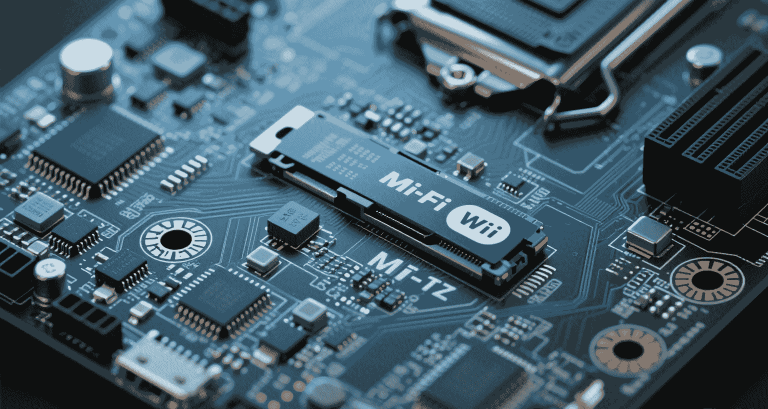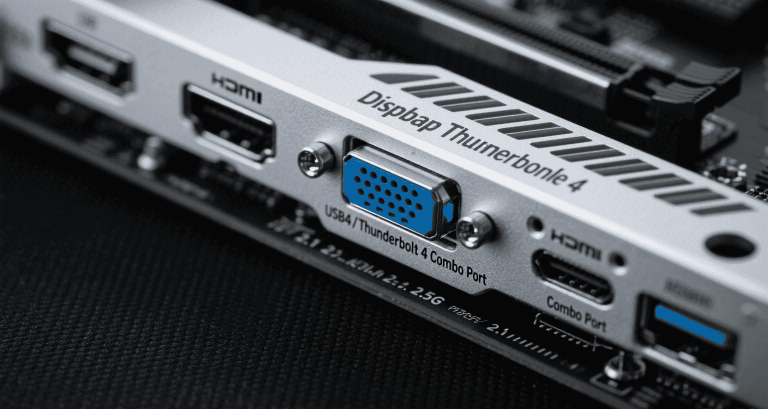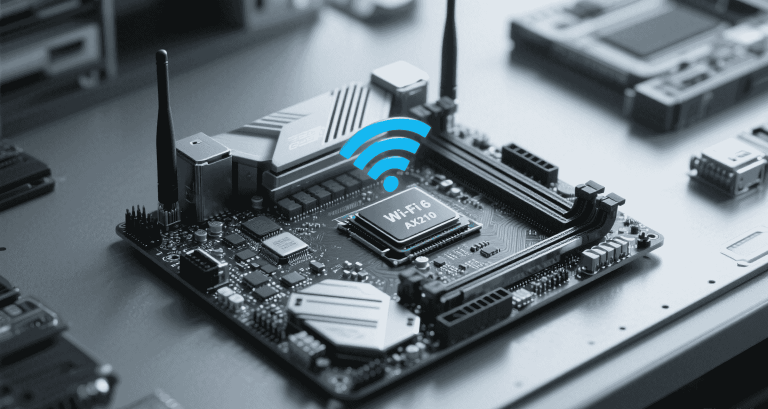Mini‑ITX Motherboards with USB4 Ports: High‑Performance Integration Guide

Table of Contents
- 1. Introduction to USB4 and Its Role in Mini‑ITX Design
- 2. Technical Overview of USB4 Architecture
- 3. USB4 Support Across CPU Platforms
- 4. Controller and Signal Routing Design Challenges
- 5. USB Power Delivery (PD) and Port Design
- 6. USB4 Performance Validation and Real‑World Bottlenecks
- 7. PCIe and DisplayPort Tunneling Behavior
- 8. Security and DMA Protection in USB4 Systems
- 9. Firmware, BIOS, and OS Compatibility Layers
- 10. Mini‑ITX USB4 Motherboard Selection Guide
- 11. Availability, Cost, and Platform Roadmap
- 12. Final Engineering Considerations and Recommendations
1. Introduction to USB4 and Its Role in Mini‑ITX Design
USB4 technology represents a turning point for compact embedded systems. Its high throughput, protocol flexibility, and port consolidation make it a game-changer for Mini‑ITX motherboards. For hardware integrators building small form factor (SFF) devices—ranging from portable workstations to industrial controllers—USB4 delivers full-function ports in minimal space.
Use cases include connecting external GPUs, NVMe enclosures, 8K monitors, and Thunderbolt docks—all with one USB‑C connector. As Mini‑ITX boards adopt USB4, understanding signal integrity, controller layout, and platform limitations is critical for successful deployment.
2. Technical Overview of USB4 Architecture
2.1 USB4 Protocol, Bandwidth, and Layered Tunneling
USB4 supports up to 40 Gbps bandwidth over dual-lane signaling using symmetric Type‑C connectors. It introduces tunneling of DisplayPort 2.0, PCIe Gen 3/4, and USB 3.2 Gen 2. Devices negotiate protocol use dynamically, with backward compatibility for USB 3.2 and 2.0.
2.2 USB4 vs Thunderbolt 3/4 vs USB 3.2
| Protocol | Max Speed | PCIe Tunneling | DP Alt Mode | Certification |
|---|---|---|---|---|
| USB 3.2 Gen 2×2 | 20 Gbps | No | Yes | No |
| Thunderbolt 3 | 40 Gbps | Yes | Yes | Intel Only |
| Thunderbolt 4 | 40 Gbps | Yes | Yes | Mandatory |
| USB4 | 40 Gbps | Yes | Yes | Optional |
3. USB4 Support Across CPU Platforms
3.1 Intel LGA1700 and Mobile Chipsets
Intel 11th to 14th Gen platforms integrate Thunderbolt 4 directly, allowing full USB4 support on compatible Mini‑ITX boards. Examples include:
- ASUS ROG Strix Z790‑I Gaming WiFi
- ASRock Z790 PG‑ITX/TB4
3.2 AMD Ryzen 7000 Series USB4 Capabilities
AMD Rembrandt and Phoenix APUs technically support USB4, but board-level implementations are inconsistent. Many Mini‑ITX AM5 boards lack USB4 ports entirely or offer USB4 with limitations in firmware or signal routing.
4. Controller and Signal Routing Design Challenges
USB4 requires precise high-speed PCB layout. Challenges include:
- Placement of retimers/redrivers near the Type‑C port
- Minimizing trace length and crosstalk between PCIe, DP, and USB signals
- Maintaining differential impedance across layers
“Many USB4 failures stem not from the controller, but poor trace layout or voltage noise under load.” — Embedded Platform Engineer
5. USB Power Delivery (PD) and Port Design
5.1 USB PD 3.1 Load Profiles in Compact Boards
Modern USB4 Mini‑ITX boards support PD 3.1 profiles including 5V/3A, 9V/3A, and 20V/5A. These require robust PD controllers and thermal planning to handle negotiation and delivery without overheating.
5.2 Type‑C Connector Mechanical and Thermal Engineering
USB4 relies on durable Type‑C ports. Boards like the ASUS Z790‑I reinforce ports with through-hole mounting and bracketed shields. Poor connector grounding or wear can cause thermal drift or unstable negotiation under load.
6. USB4 Performance Validation and Real‑World Bottlenecks
6.1 Bandwidth Issues in USB‑C Storage/Display Devices
In practice, many devices fail to utilize full USB4 bandwidth due to:
- Low-quality USB‑C cables
- Improper tunneling configuration in BIOS
- Driver or OS-level fallback to USB 3.x modes
6.2 Signal Degradation, Latency, and Interference Risks
Interference from internal power planes and adjacent traces may cause issues. Shielded trace lanes and clean VRM layout near USB4 paths are essential for sustained 40 Gbps signaling.
7. PCIe and DisplayPort Tunneling Behavior
7.1 PCIe eGPU Use Cases and Bottlenecks
External GPUs using USB4 typically operate over PCIe x4 tunneling. While good for lightweight workloads, it lags behind native x16 slots. Latency-sensitive applications (e.g., VR, CAD) may suffer performance drops.
7.2 DisplayPort 2.0 / Alt Mode in Dual‑Use Ports
Boards supporting DP Alt Mode via USB4 allow for dual-display output, 4K60, or even 8K30 where supported. Proper muxing logic is required to prevent display blackouts during re-negotiation.
8. Security and DMA Protection in USB4 Systems
USB4 exposes DMA attack surfaces if PCIe tunneling is not secured. Thunderbolt-certified ports enforce IOMMU mapping and DMA whitelists, but generic USB4 ports may not. Recommendations:
- Enable IOMMU in BIOS
- Use secure boot firmware with port whitelisting
- Avoid untrusted USB4 docks in embedded applications
9. Firmware, BIOS, and OS Compatibility Layers
9.1 BIOS USB4 Configuration and Lane Allocation
Some BIOS implementations offer toggles for USB4, lane bonding, or PD settings. These options are often undocumented or behind firmware locks—always update to the latest UEFI version before deployment.
9.2 Linux/Windows USB4 Driver Support and Logs
USB4 is natively supported in:
- Linux kernel ≥ 5.6 with tools like
boltctlfor Thunderbolt tunneling - Windows 11 with integrated USB4 support via Connection Manager
10. Mini‑ITX USB4 Motherboard Selection Guide
10.1 Intel-Based Mini‑ITX Boards with USB4
| Board | USB4 Support | Features |
|---|---|---|
| ASRock Z790 PG‑ITX/TB4 | Yes (TB4) | PCIe 5.0, 3× M.2, Intel LGA1700 |
| ASUS ROG Strix Z790‑I | Yes (TB4) | Thunderbolt, Wi-Fi 6E, dual DP |
| Gigabyte Z790I AORUS Ultra | Partial | Gen 2×2 USB‑C (verify USB4) |
10.2 AMD-Based USB4 Mini‑ITX Boards
Options are limited. The ASUS ROG Strix X870‑I is one of the few AM5 boards to offer full USB4 with firmware support.
11. Availability, Cost, and Platform Roadmap
11.1 USB4 Premium and Feature Fragmentation
Boards with USB4 carry higher costs due to retimers, PD circuitry, and certification. Intel Mini‑ITX boards dominate in USB4 reliability—most AMD ITX boards exclude USB4 to save cost or PCB space.
11.2 USB4 Version 2.0 (80 Gbps) Roadmap for ITX
USB4 v2.0 supporting 80 Gbps and DP2.1 tunneling was ratified in early 2024. ITX boards have yet to support v2.0 in volume. Expect availability from mid–2025 onward.
12. Final Engineering Considerations and Recommendations
12.1 Best Practices for Integrating USB4 in SFF Designs
- Check USB4 routing near high-speed traces for interference
- Confirm cable compatibility and real-world port speeds
- Update BIOS/UEFI firmware and monitor PD negotiation logs
12.2 When USB4 Is Essential vs Optional
Use USB4 if you:
- Use eGPUs or Thunderbolt docks in small enclosures
- Need multiple 4K displays from a single port
- Deploy high-speed NVMe backup over USB‑C
✅ Summary
- Intel Mini‑ITX boards like ASUS Z790‑I and ASRock Z790 PG‑ITX are the safest picks for USB4 stability
- AMD USB4 ITX support remains fragmented and niche
- USB4 performance hinges on board layout, firmware, and connector durability
- Always test real-world devices—not just specs




